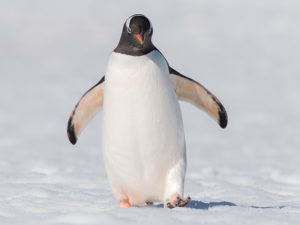
Take it slow on the ice and walk like a penguin
Don’t let the ice have you slipping and sliding away.
According to the National Safety Council, 25,000 slip, trip and fall accidents occur daily in the United States.
Even penguins slip up
Nearly all injuries from slips and falls on snow and ice fall under the classification of “traumatic injuries.” These injuries range from minor bruises, cuts and abrasions to serious bone fractures, spinal cord damage and concussions, according to the National Safety Council.
“Slipping and falling accounts for a large number of winter-related injuries and can have an impact on the quality of life for the injured person,” said Dianne Endress, an advanced practice registered nurse who sees patients at OSF OnCall Urgent Care clinics in the Peoria area. “The most common injuries encountered as a result of slipping on the ice are head injuries as well as fractured arms, legs and hips.
“Falls commonly occur when a person is getting out of their vehicle or walking in a parking lot or on a sidewalk,” Endress said. “Another danger spot is encountered upon entering a building from wet surfaces caused by prior patrons tracking in snow or ice.”
Walk like a penguin
The Farmer’s Almanac, which provides annual weather forecasts among a collection of other useful information, says people who live in colder climates are more acclimated to walking on icy surfaces because they have learned to walk like a penguin.

To walk like a penguin, do the following:
- Bend slightly and walk flat footed
- Keep your center of gravity over your feet as much as possible
- Point your feet out slightly – well, like a penguin
- Shuffle your feet and take short steps
- Watch where you are stepping
- Concentrate on keeping your balance
- Keep your arms at your sides and hands out of your pockets
- Go slow
The Farmer’s Almanac also recommends treating your feet by having good winter boots with a large tread or you can wear ice cleats that attach to your shoes and provides gripping power on ice.
Learn how to take a fall
People should also learn how to fall to prevent seriously hurting themselves. The most important thing, according to the Farmer’s Almanac, is to protect your head. Bones will heal, a head injury can be an entirely different matter and could even result in death.
Here are some tips on how to protect your head during a fall:
- If you feel yourself beginning to fall, tuck your chin against your chest to prevent your head from hitting the ice or pavement
- Cradle your arms around your head
- As you fall, try to fold your body into itself, which helps to decrease the height of the fall
- As you hit the ground, roll and exhale sharply to tense up your body and allow for it to absorb the impact
- Never try breaking a fall by bracing yourself with your hand as it likely will only result in a sprain or a break